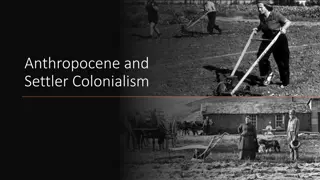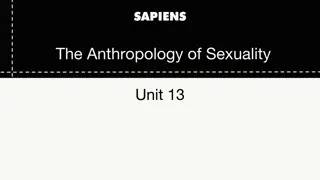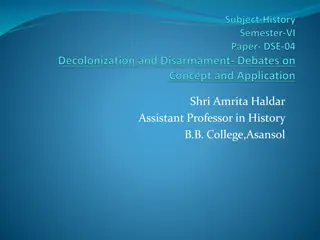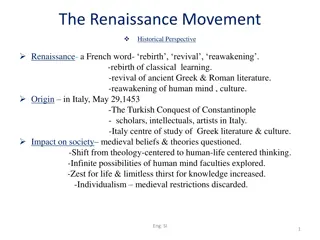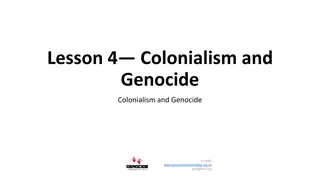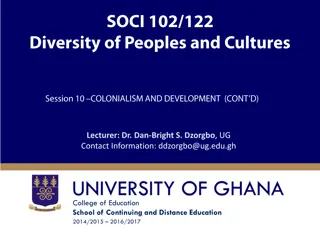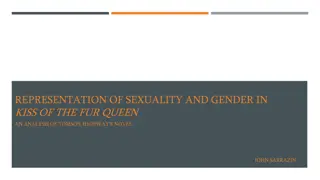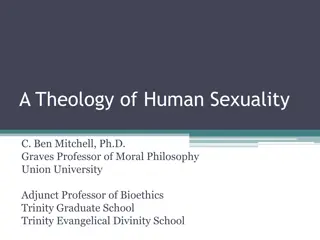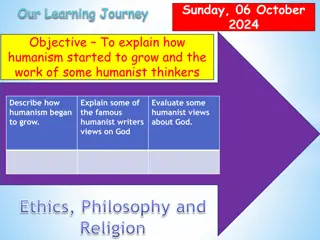E.M. Forster: Humanism, Sexuality, and Colonialism in Literature
Forster, a prominent humanist and author, intricately weaves themes of personal connections, class struggles, and societal restrictions in his works. His exploration of sexuality, particularly the shift from heterosexual to homosexual love, is notable. Through novels like "A Passage to India," he delves into the complexities of English-Indian friendships amidst British colonialism, portraying the potential for understanding and conflict. Forster's use of symbolism and mysticism adds depth to his narratives.
Download Presentation

Please find below an Image/Link to download the presentation.
The content on the website is provided AS IS for your information and personal use only. It may not be sold, licensed, or shared on other websites without obtaining consent from the author.If you encounter any issues during the download, it is possible that the publisher has removed the file from their server.
You are allowed to download the files provided on this website for personal or commercial use, subject to the condition that they are used lawfully. All files are the property of their respective owners.
The content on the website is provided AS IS for your information and personal use only. It may not be sold, licensed, or shared on other websites without obtaining consent from the author.
E N D
Presentation Transcript
Forster was President of the Cambridge Humanists from 1959 until his death and a member of the Advisory Council of the British Humanist Association from 1963 until his death. His views as a humanist are at the heart of his work, which often depicts the pursuit of personal connections in spite of the restrictions of contemporary society. His humanist attitude is expressed in the non-fictional essay WhatI Believe Forster's two best-known works, A Passage to India and Howards End, explore the irreconcilability of class differences. A Room with a View also shows how questions of propriety and class can make human connection difficult.
Sexuality is another key theme in Forster's works. Some critics have argued that a general shift from heterosexual to homosexual love can be observed through the course of his writing career. The foreword to Maurice describes his struggle with his homosexuality, while he explored similar issues in several volumes of short stories. Forster's explicitly homosexual writings, the novel Maurice and the short story collection The Life to Come, were published shortly after his death. Forster is noted for his use of symbolism as a technique in his novels,andhe has been criticized for his attachment to mysticism. Mrs Moore in A Passage to India have a mystical link with the past, and a striking ability to connect with people from beyond their owncircles.
Forster achieved his greatest success with A Passage to India (1924). The novel takes as its subject the relationship between East and West, seen through the lens of India in the later days of the British Raj. Forster connects personal relationships with the politics of colonialism through Englishwoman Adela Quested, the Indian Dr. Aziz, and the question of what did or did not happenbetweenthemintheMarabarCaves the story of the
The Difficulty of English-Indian Friendship A Passage to India begins and ends by posing the question of whether it is possible for an Englishman and an Indian to ever be friends, at least within the context of British colonialism. Forster uses this question as a framework to explore the general issue of Britain s political control of India on a more personal level, through the friendship between Aziz and Fielding. At the beginning of the novel, Aziz is scornful of the English, wishing only to consider them comically or ignore them completely. Yet the intuitive connection Aziz feels with Mrs. Moore in the mosque opens him to the possibility of friendship with Fielding. Through the first half of the novel, Fielding and Aziz represent a positive model of liberal humanism: Forster suggests that British rule in India could be successful and respectful if only English and Indians treated each other as Fielding and Aziz treat each other as worthy individuals who connect through frankness, intelligence, andgoodwill.
Yet in the aftermath of the novels climaxAdelas accusation that Aziz attempted to assault her and her subsequent disavowal of this accusation at the trial Aziz and Fielding s friendship falls apart. The strains on their relationship are external in nature, as Aziz and Fielding both suffer from the tendencies of their cultures. Aziz tends to let his imagination run away with him and to let suspicion harden into a grudge. Fielding suffers from an English literalism and rationalism that blind him to Aziz s true feelings and make Fielding too stilted to reach out to Aziz through conversations or letters. Furthermore, their respective Indian and English communities pull them apart through their mutual stereotyping. As we see at the end of the novel, even the landscape of India seems to oppress their friendship. Forster s final vision of the possibility of English-Indian friendship is a pessimistic one, yet it is qualified by the possibility of friendship on English soil, or after the liberation of India. As the landscape itself seems to imply at the end of the novel,suchafriendshipmay be possibleeventually,but notyet
TheUnity ofAllLivingThings Though the main characters of A Passage to India are generally Christian or Muslim, Hinduism also plays a large thematic role in the novel. The aspect of Hinduism with which Forster is particularly concerned is the religion s ideal of all living things, from the lowliest to the highest, united in love as one. This vision of the universe appears to offer redemption to India through mysticism, as individual differences disappear into a peaceful collectivity that does not recognize hierarchies. Individual blame and intrigue is forgone in favor of attention to higher, spiritual matters. Professor Godbole, the most visible Hindu in the novel, is Forster s mouthpiece for this idea of the unity of all living things. Godbole alone remains aloof from the drama of the plot, refraining from taking sides by recognizing that all are implicated in the evil of Marabar. Mrs. Moore, also, shows openness to this aspect of Hinduism. Though she is a Christian, her experience of India has made her dissatisfied with what she perceives as the smallness of Christianity. Mrs. Moore appears to feel a great sense of connection with all living creatures, as evidenced by her respectfor thewaspinher bedroom.
Yet, through Mrs. Moore, Forster also shows that the vision of the oneness of all living things can be terrifying. As we see in Mrs. Moore s experience with the echo that negates everything into boum in Marabar, such oneness provides unity but also makes all elements of the universe one and the same a realization that, it is implied, ultimately kills Mrs. Moore. Godbole is not troubled by the idea that negation is an inevitable result when all things come together as one. Mrs. Moore, however, loses interest in the world of relationships after envisioning this lack of distinctions as a horror. Moreover, though Forster generally endorses the Hindu idea of the oneness of all living things, he also suggests that there may be inherent problems with it. Even Godbole, for example, seems to recognize that something if only a stone must be left out of the vision of oneness if the vision is to cohere. This problem of exclusion is, in a sense, merely another manifestation of the individual difference andhierarchythatHinduism promisestoovercome.
The Muddle of India Forster takes great care to strike a distinction between the ideas of muddle and mystery in A Passage to India. Muddle has connotations of dangerous and disorienting disorder, whereas mystery suggests a mystical, orderly plan by a spiritual force that is greater than man. Fielding, who acts as Forster s primary mouthpiece in the novel, admits that India is a muddle, while figures such as Mrs. Moore and Godbole view India as a mystery. The muddle that is India in the novel appears to work from the ground up: the very landscape and architecture of the countryside is formless, and the natural life of plants and animals defies identification. This muddled quality to the environment is mirrored in the makeup of India s native population, which is mixed into a muddle of different religious, ethnic, linguistic, and regional groups.
The muddle of India disorients Adela the most; indeed, the events at the Marabar Caves that trouble her so much can be seen as a manifestation of this muddle. By the end of the novel, we are still not sure what actually has happened in the caves. Forster suggests that Adela s feelings about Ronny become externalized and muddled in the caves, and that she suddenly experiences these feelings as something outside of her. The muddle of India also affects Aziz and Fielding s friendship, as their good intentions are derailedby thechaosof cross-cultural signals
The Negligence of BritishColonialGovernment Though A Passage to India is in many ways a highly symbolic, or even mystical, text, it also aims to be a realistic documentation of the attitudes of British colonial officials in India. Forster spends large sections of the novel characterizing different typical attitudes the English hold toward the Indians whom they control. Forster s satire is most harsh toward Englishwomen, whom the author depicts as overwhelmingly racist, self-righteous, and viciously condescending to the native population. Some of the Englishmen in the novel are as nasty as the women, but Forster more often identifies Englishmen as men who, though condescending and unable to relate to Indians on an individual level, are largely well-meaning and invested in their jobs. For all Forster s criticism of the British manner of governing India, however, he does not appear to question the right of the British Empire to rule India. He suggests that the British would be well served by becoming kinder and more sympathetic to the Indians with whom they live, but he does not suggest that the British should abandon India outright. Even this lesser critique is never overtly stated in the novel, but implied through biting satire.


